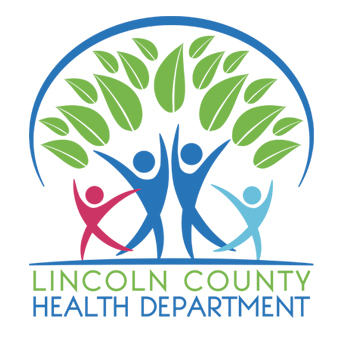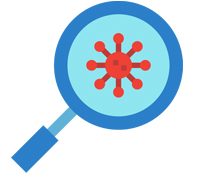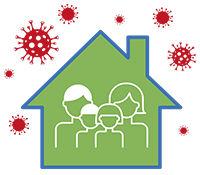Staying Healthy
The best way to prevent illness is to avoid being exposed. There are simple precautions you can take to reduce your risk of infection. If you are at higher risk of disease, please check with your healthcare provider about other ways to protect yourself.
*Information sourced from the CDC and Montana COVID-19 websites.
How to Protect Yourself & Others
Know how it spreads
COVID-19 spreads easily from person to person, mainly by the following routes:
- Between people who are in close contact with one another (within 6 feet).
- Through respiratory droplets produced when an infected person coughs, sneezes, breathes, sings or talks.
- Respiratory droplets cause infection when they are inhaled or deposited on mucous membranes, such as those that line the inside of the nose and mouth.
- People who are infected but do not have symptoms can also spread the virus to others.
Less common ways COVID-19 can spread
- Under certain circumstances (for example, when people are in enclosed spaces with poor ventilation).
- COVID-19 can sometimes be spread by airborne transmission.
- COVID-19 spreads less commonly through contact with contaminated surfaces.
Everyone Should…
Wash Your Hands Often
Wash your hands often with soap and water for at least 20 seconds especially after you have been in a public place, or after blowing your nose, coughing, or sneezing.
It’s especially important to wash:
- Before eating or preparing food
- Before touching your face
- After using the restroom
- After leaving a public place
- After blowing your nose, coughing, or sneezing
- After handling your mask
- After changing a diaper
- After caring for someone sick
- After touching animals or pets
If soap and water are not readily available, use a hand sanitizer that contains at least 60% alcohol. Cover all surfaces of your hands and rub them together until they feel dry. Avoid touching your eyes, nose, and mouth with unwashed hands.
Avoid Close Contact
Inside your home:
- Avoid close contact with people who are sick.
- If possible, maintain 6 feet between the person who is sick and other household members.
Outside your home:
- Put 6 feet of distance between yourself and people who don’t live in your household.
- Remember that some people without symptoms may be able to spread virus.
- Stay at least 6 feet (about 2 arms’ length) from other people.
- Keeping distance from others is especially important for people who are at higher risk of getting very sick.
Cover Your Mouth and Nose with a Mask When Around Others
- You could spread COVID-19 to others even if you do not feel sick.
- The mask is meant to protect other people in case you are infected.
- Everyone should wear a mask in public settings and when around people who don’t live in your household, especially when other social distancing measures are difficult to maintain.
- Masks should not be placed on young children under age 2, anyone who has trouble breathing, or is unconscious, incapacitated or otherwise unable to remove the mask without assistance.
- Do NOT use a mask meant for a healthcare worker. Currently, surgical masks and N95 respirators are critical supplies that should be reserved for healthcare workers and other first responders.
- Continue to keep about 6 feet between yourself and others. The mask is not a substitute for social distancing.
Cover Coughs and Sneezes
- Always cover your mouth and nose with a tissue when you cough or sneeze or use the inside of your elbow and do not spit.
- Throw used tissues in the trash.
- Immediately wash your hands with soap and water for at least 20 seconds. If soap and water are not readily available, clean your hands with a hand sanitizer that contains at least 60% alcohol.
Clean and Disinfect
Clean AND disinfect frequently touched surfaces daily. This includes tables, doorknobs, light switches, countertops, handles, desks, phones, keyboards, toilets, faucets, and sinks.
If surfaces are dirty, clean them. Use detergent or soap and water prior to disinfection.
Then, use a household disinfectant. Most common EPA-registered household disinfectant.
Build a Healthy Immune System
- Eat a healthy diet rich in vegetables, fruits, and whole grains
- Drink plenty of water to stay hydrated.
- Exercise regularly.
- Maintain a healthy weight.
- Get enough sleep.
- Control your stress level.
- Don’t smoke, vape, or use tobacco products.
Monitor Your Health Daily
- Be alert for symptoms.
Watch for fever, cough, shortness of breath, or other symptoms of COVID-19.
Especially important if you are running essential errands, going into the office or workplace, and in settings where it may be difficult to keep a physical distance of 6 feet. - Take your temperature if symptoms develop.
Don’t take your temperature within 30 minutes of exercising or after taking medications that could lower your temperature, like Acetaminophen (Tylenol). - Follow CDC guidance if symptoms develop.
Protect Your Health This Flu Season
It’s likely that flu viruses and the virus that causes COVID-19 will both spread this fall and winter. Healthcare systems could be overwhelmed treating both patients with flu and patients with COVID-19. This means getting a flu vaccine during 2020-2021 is more important than ever.
Learn more about how to protect your health this flu season here.
While getting a flu vaccine will not protect against COVID-19 there are many important benefits, such as:
- Flu vaccines have been shown to reduce the risk of flu illness, hospitalization, and death.
- Getting a flu vaccine can also save healthcare resources for the care of patients with COVID-19.
Call the Lincoln County Health Nurse at 283-2447 to schedule your flu vaccine.
Social Distancing
When going out in public, it is important to stay at least 6 feet away from other people and wear a mask to slow the spread of COVID-19. Consider the following tips for practicing social distancing when you decide to go out.
What is Social Distancing?
Social distancing, also called “physical distancing,” means keeping a safe space between yourself and other people who are not from your household.
To practice social or physical distancing, stay at least 6 feet (about 2 arms’ length) from other people who are not from your household in both indoor and outdoor spaces.
Social distancing should be practiced in combination with other everyday preventive actions to reduce the spread of COVID-19, including wearing masks, avoiding touching your face with unwashed hands, and frequently washing your hands with soap and water for at least 20 seconds.
Why Practice Social Distancing?
COVID-19 spreads mainly among people who are in close contact (within about 6 feet) for a prolonged period. Spread happens when an infected person coughs, sneezes, or talks, and droplets from their mouth or nose are launched into the air and land in the mouths or noses of people nearby. The droplets can also be inhaled into the lungs. Recent studies indicate that people who are infected but do not have symptoms likely also play a role in the spread of COVID-19. Since people can spread the virus before they know they are sick, it is important to stay at least 6 feet away from others when possible, even if you—or they—do not have any symptoms. Social distancing is especially important for people who are at higher risk for severe illness from COVID-19.
If you are sick with COVID-19, have symptoms consistent with COVID-19, or have been in close contact with someone who has COVID-19, it is important to stay home and away from other people until it is safe to be around others.
COVID-19 can live for hours or days on a surface, depending on factors such as sunlight, humidity, and the type of surface. It may be possible that a person can get COVID-19 by touching a surface or object that has the virus on it and then touching their own mouth, nose, or eyes. However, this is not thought to be the main way the virus spreads. Social distancing helps limit opportunities to come in contact with contaminated surfaces and infected people outside the home.
Although the risk of severe illness may be different for everyone, anyone can get and spread COVID-19. Everyone has a role to play in slowing the spread and protecting themselves, their family, and their community. In addition to practicing everyday steps to prevent COVID-19, keeping space between you and others is one of the best tools we have to avoid being exposed to this virus and slowing its spread in communities.
Limit Contact When Running Errands
Only visit stores selling household essentials in person when you absolutely need to, and stay at least 6 feet away from others who are not from your household while shopping and in lines. If possible, use drive-thru, curbside pick-up, or delivery services to limit face-to-face contact with others. Maintain physical distance between yourself and delivery service providers during exchanges and wear a mask.
Choose Safe Social Activities
It is possible to stay socially connected with friends and family who don’t live in your home by calling, using video chat, or staying connected through social media. If meeting others in person (e.g., at small outdoor gatherings, yard or driveway gathering with a small group of friends or family members), stay at least 6 feet from others who are not from your household. Follow these steps to stay safe if you will be participating in personal and social activities outside of your home.
Keep Distance at Events and Gatherings
It is safest to avoid crowded places and gatherings where it may be difficult to stay at least 6 feet away from others who are not from your household. If you are in a crowded space, try to keep 6 feet of space between yourself and others at all times, and wear a mask. Masks are especially important in times when physical distancing is difficult. Pay attention to any physical guides, such as tape markings on floors or signs on walls, directing attendees to remain at least 6 feet apart from each other in lines or at other times. Allow other people 6 feet of space when you pass by them in both indoor and outdoor settings.
Stay Distanced While Being Active
Consider going for a walk, bike ride, or wheelchair roll in your neighborhood or in another safe location where you can maintain at least 6 feet of distance between yourself and other pedestrians and cyclists. If you decide to visit a nearby park, trail, or recreational facility, first check for closures or restrictions. If open, consider how many other people might be there and choose a location where it will be possible to keep at least 6 feet of space between yourself and other people who are not from your household.
Mental Health
Many Montanans are struggling with isolation, loss, fear, uncertainty or depression due to the ongoing impacts of the COVID-19 public health emergency. Actions that are necessary to reduce the spread of COVID-19, such as social distancing and avoiding gatherings, can make people feel lonely and can increase stress and anxiety.
Recognize the Signs
Stress can cause:
- Fear and worry about your own health and the health of your loved ones, your financial situation or job, or loss of support services you rely on.
- Changes in sleep or eating patterns.
- Difficulty sleeping or concentrating.
- Worsening of chronic health problems.
- Worsening of mental health conditions.
- Increased use of tobacco, and/or alcohol and other substances.
Everyone Reacts Differently to Stressful Situations
How you respond to stress during the COVID-19 pandemic can depend on your background, your social support from family or friends, your financial situation, your health and emotional background, the community you live in, and many other factors. The changes that can happen because of the COVID-19 pandemic and the ways we try to contain the spread of the virus can affect anyone.
People who may respond more strongly to the stress of a crisis include:
- People who are at higher risk for severe illness from COVID-19 (for example, older people, and people of any age with certain underlying medical conditions).
- Children and teens.
- People caring for family members or loved ones.
- Frontline workers such as health care providers and first responders.
- Essential workers who work in the food industry.
- People who have existing mental health conditions.
- People who use substances or have a substance use disorder.
- People who have lost their jobs, had their work hours reduced, or had other major changes to their employment.
- People who have disabilities or developmental delay.
- People who are socially isolated from others, including people who live alone, and people in rural or frontier areas.
- People in some racial and ethnic minority groups.
- People who do not have access to information in their primary language.
- People experiencing homelessness.
- People who live in congregate (group) settings.
Healthy Ways to Cope with Stress
Taking care of your friends and your family can be a stress reliever, but it should be balanced with care for yourself. Helping others cope with their stress, such as by providing social support, can also make your community stronger. During times of increased social distancing, people can still maintain social connections and care for their mental health. Phone calls or video chats can help you and your loved ones feel socially connected, less lonely, or isolated.
- Know what to do if you are sick and are concerned about COVID-19. Contact a health professional before you start any self-treatment for COVID-19.
- Know where and how to get treatment and other support services and resources, including counseling or therapy (in person or through telehealth services).
- Take care of your emotional health. Taking care of your emotional health will help you think clearly and react to the urgent needs to protect yourself and your family.
- Take breaks from watching, reading, or listening to news stories, including those on social media. Hearing about the pandemic repeatedly can be upsetting.
- Take care of your body.
- Take deep breaths, stretch, or meditate.
- Try to eat healthy, well-balanced meals.
- Exercise regularly.
- Get plenty of sleep.
- Avoid excessive alcohol and drug use.
- Make time to unwind. Try to do some other activities you enjoy.
- Connect with others. Talk with people you trust about your concerns and how you are feeling.
- Connect with your community or faith-based organizations. While social distancing measures are in place, consider connecting online, through social media, or by phone or mail.
Get Help
- To get immediate help in a crisis, call 911.
- The Montana Crisis Recovery Line is available Monday to Friday 10 a.m. to 10 p.m. at 877-503-0833. This hotline provides free and confidential counseling services from trained counselors who will listen without judgement, offer emotional support, comfort, console, offer information and education on stress and coping, and direct callers to additional support and community resources.
- The Crisis Text Line is available 24/7 by texting MT to 741 741
- The Montana Suicide Prevention Lifeline is available 24/7 at 800-273-TALK (8255)
- The Warmline is available Monday to Friday 8 a.m. to 9 p.m. and Saturday and Sunday noon to 9 p.m. at 877-688-3377
- Thrive is a confidential online program that helps people deal with stress, depression and anxiety. Visit https://thriveformontana.com.
- How Right Now is a CDC initiative that provides information and tools on how to reduce stress. Visit https://howrightnow.org.




